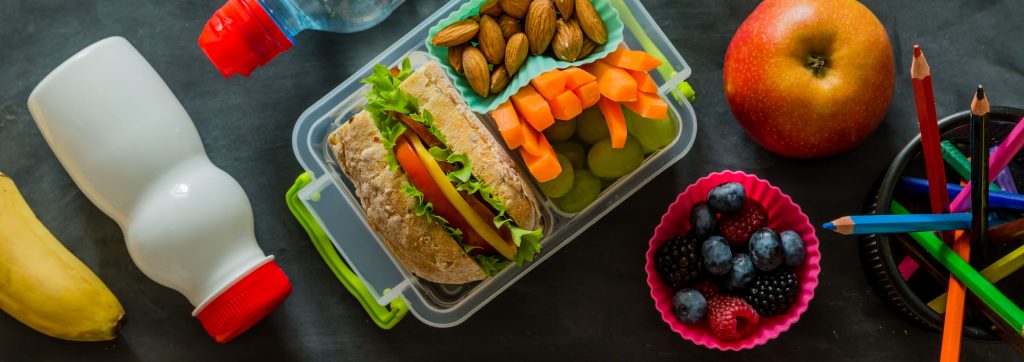Lunchbox Lessons from Lara
Just last summer, USDA launched MyPlate, a revamp of the old food guide pyramid which seemed to create consumer confusion. Rather than a pyramid, the “plate” depicts nutritional know-how in one image. At first sight, the plate shows the five food groups: fruits, vegetables, grains and proteins, along with a glass of milk. However, if you look at it closer, this familiar mealtime image of a place setting reminds us of healthy eating and balance.

Vitamin-packed fruits and vegetables should be about half of our plate. The other half is reserved for proteins and grains. There are no pictures or symbols of what are contained in these groups, which gives consumers flexibility. Michael Pollan said it best, “Eat food. Not too much. Mostly plants.” Too frequently our lunches are comprised of an abundance of refined starches, which brings me to my top lunchbox lessons.
- Forget the sandwich, and think outside the lunchbox. Lunch should include 5 items, at least, one from each group, nothing less. Many times kids are focused on the “fun” stuff in their lunch (chips, cookies, fruit snacks, etc.); the sandwich is the first thing they “forget to eat.” Instead, make lunch seem more like snacks–easier to eat, but equal or better nutrition. For instance, cucumber slices (VEGETABLE), hummus (PROTEIN), yogurt (DAIRY), dried blueberries (FRUIT) and whole grain pretzels (GRAIN). Avoid excess refined carbohydrates (white bread, crackers, cookies, chips). Many times, parents pack the following: sandwich on whole wheat bread, carrots, chips and cookies. This lunch is too top heavy on grains. Calcium-rich dairy and alternative dairy products should be included in every lunch–low-fat yogurt, cottage cheese or even rice pudding. Kids need about 3-4 servings daily, which makes calcium-rich foods a lunch time necessity.
- Focus on fiber! Fiber-rich foods help manage blood glucose control, aid in digestion, and also make us feel full, and thus prevent overeating. Look for products with at least 3 g fiber/serving. Fiber is not only contained in fruits, vegetables and whole grains, but also in some excellent protein-containing foods such as beans. Try a whole grain tortilla and spread some refried beans and top with melted low-fat cheese or add Great Northern beans to your next pasta dinner. In lieu of chips, try Mediterranean Snacks baked lentil chips. With 3 g fiber and 4 g protein, these snacks are a great option for lunch.
- Get the kids involved! If kids are part of the process, they are more likely to succeed in eating lunch. Have kids help with grocery shopping and food preparation to promote healthy habits.
- Quit while you are ahead! Avoid the clean-your-plate club. Kids shouldn’t feel pressure to finish all that is in their lunch; that can promote overeating. Ask kids to bring home what they don’t finish.
Find some fun gear to pack the lunches, such as those from Laptop Lunches: www.laptoplunches.com. Don’t forget to keep it cool. Try freezing tube yogurts and throwing them into the lunch instead of an ice pack.
Have fun with lunch and remember these lunchbox lessons from FEED. For more individualized attention, please contact lara@feednutrition.com